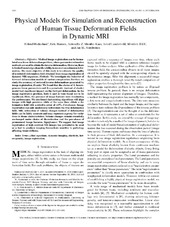| dc.contributor.author | Hodneland, Erlend | en_US |
| dc.contributor.author | Hanson, Erik Andreas | en_US |
| dc.contributor.author | Munthe-Kaas, Antonella Z. | en_US |
| dc.contributor.author | Lundervold, Arvid | en_US |
| dc.contributor.author | Nordbotten, Jan Martin | en_US |
| dc.date.accessioned | 2017-03-15T14:25:07Z | |
| dc.date.available | 2017-03-15T14:25:07Z | |
| dc.date.issued | 2016-10 | |
| dc.Published | IEEE Transactions on Biomedical Engineering 2016, 63(10):2200-2210 | eng |
| dc.identifier.issn | 0018-9294 | |
| dc.identifier.uri | https://hdl.handle.net/1956/15592 | |
| dc.description.abstract | Objective: Medical image registration can be formulated as a tissue deformation problem, where parameter estimation methods are used to obtain the inverse deformation. However, there is limited knowledge about the ability to recover an unknown deformation. The main objective of this study is to estimate the quality of a restored deformation field obtained from image registration of dynamic MR sequences. Methods: We investigate the behavior of forward deformation models of various complexities. Further, we study the accuracy of restored inverse deformations generated by image registration. Results: We found that the choice of 1) heterogeneous tissue parameters and 2) a poroelastic (instead of elastic) model had significant impact on the forward deformation. In the image registration problem, both 1) and 2) were found not to be significant. Here, the presence of image features were dominating the performance. We also found that existing algorithms will align images with high precision while at the same time obtain a deformation field with a relative error of 40%. Conclusion: Image registration can only moderately well restore the true deformation field. Still, estimation of volume changes instead of deformation fields can be fairly accurate and may represent a proxy for variations in tissue characteristics. Volume changes remain essentially unchanged under choice of discretization and the prevalence of pronounced image features. Significance: We suggest that image registration of high-contrast MR images has potential to be used as a tool to produce imaging biomarkers sensitive to pathology affecting tissue stiffness. | en_US |
| dc.language.iso | eng | eng |
| dc.publisher | IEEE | eng |
| dc.rights | Attribution CC BY | eng |
| dc.rights.uri | http://creativecommons.org/licenses/by/3.0/ | eng |
| dc.subject | Biot equations | eng |
| dc.subject | dynamic imaging | eng |
| dc.subject | elasticity | eng |
| dc.subject | heterogeneity | eng |
| dc.subject | image registration | eng |
| dc.title | Physical models for simulation and reconstruction of human tissue deformation fields in dynamic MRI | en_US |
| dc.type | Peer reviewed | |
| dc.type | Journal article | |
| dc.date.updated | 2016-12-13T10:46:28Z | |
| dc.description.version | publishedVersion | en_US |
| dc.rights.holder | Copyright 2016 The Author(s) | |
| dc.identifier.doi | https://doi.org/10.1109/tbme.2015.2514262 | |
| dc.identifier.cristin | 1394670 | |

